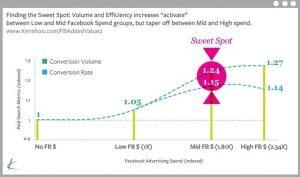Columnist Chris Liversidge explains why fixing your analytics gaps and taking lifetime customer value into account can lead to better results in your organic search initiatives.

I recently attended Edinburgh’s Turing Festival. (It’s a fantastic tech conference, and of course, Edinburgh is a fantastic city; you should go!)
Speakers included many names familiar to those in the online marketing industry, such as Moz’s Rand Fishkin, Seer Interactive’s Wil Reynolds and Unbounce’s Oli Gardner. And while each presentation had a high standard with thoughtful takeaways, the most insightful speaker to me was Andy Young.
Young spoke about data-driven growth, and although his presentation was more tailored to startups, it had strong parallels for in-house and agency marketers looking to help their businesses or clients gain an edge in their digital marketing strategy. In particular, he talked about how to build cohort segmentation into your web performance analysis to discover which marketing channels were generating better customers.
Young neatly defined solving lifetime value analysis as a subset of correctly attributing direct traffic, so that a user can be further classified as part of an LTV assessment at a later date. (Another challenge on our path will be assessing our attribution model generally, but let’s leave that for another day.)
Here are some key approaches:
- Appropriately tag visitors to common “existing customer” URLs. For example, visitors to domain.com/reset or domain.com/login are users with an existing account that can be matched back to their original converting UTM session. This will likely allow you to tag up to 50 percent of your direct traffic for B2C businesses.
- Ensure app deep link tracking feeds back into your data warehouse (for example, Branch, Adjust, Appsflyer).
- Offline, ensure customers are asked where they came from and/or how they first heard about you — and similarly attribute back.
- Use call tracking. You can if you run paid campaigns. Do it!
- Use landing pages or custom tooling in your web analytics platform to tag free social, email, product notifications and so on, so you’re putting customers into the funnel as cleanly attributed as possible.
I strongly agree with Andy Young here that it is usually possible to get everything tracked — what is often lacking is the will. The main takeaway from Young’s talk that you need to fix your analytics gaps.
Lifetime value and cohort behaviors
Taking the baton, what I find most useful as an outcome of this streamlined thinking is that it solves the majority of gaps for creating a LTV (or Lifetime Value) calculation that adds a lot of value for organic strategy in particular.
At the very least, you can get to a pretty good approximation of a LTV calculation for the majority of your customers and get a useful insight and clear action out of your calculations to test back against its impact on your business bottom line.
If you understand your customer cohort behaviors, you can work to a LTV that allows you to test progress along the expected cohort path to their ultimate LTV. So you don’t need to wait six or 12 months before you declare your LTV model a success or off the mark — you can implement it and check if your cohorts are going in the right direction.
If they are, then you are already winning. If you’ve done a really good job of tagging, you can probably refine further at this early stage, the better to drive competitive advantage for your clients.
Why is it useful to know your LTV? To keep the answer simple, if your CoS (Cost of Sale) in a particular channel is lower than your LTV, then you have a business. More importantly for digital marketers — if you don’t know your LTV, it’s quite likely you may be…
- Underspending on your real maximum CPCs in paid search.
- Not spending enough in front of the right demographics in programmatic or classic display, or via email promotion.
- Not offering perks (such as, say, free delivery at lower spends) which have serious impact on your conversion rates.
- Not prioritizing page load performance enough. (I mean, seriously, it’s getting worse.)
How does this relate to SEO strategy?
I take a view of organic traffic growth as a path to organic customer growth. That path needs to work with your other marketing channels — particularly paid search, as you are operating on the same playing field (the SERP) and showing a marketing message to the same eyeballs.
You can’t correctly prioritize target organic keyphrase terms if you don’t know how much they contribute to your high-LTV customers. And similarly, if you have to reconfigure your paid campaigns to better prioritize terms a particular high-value cohort has, you need to support that shortfall with organic search.
In short: Your overarching keyphrase strategy should be matched to cohort analysis resting on a LTV value model.
In the same vein, page call-to-action (CTA) messaging value can be assessed by looking at your organic and paid cohort’s contribution to LTV further down the funnel: Do you get a higher initial spend but lower LTV customer with CTA A (20-percent discount and free delivery) versus CTA B (Tell a friend and we’ll give you a $50 gift voucher) in the SERPs? Is one CTA in particular better for organic last-click converters or paid? Do brand term searches on second devices (mobile/tablet at home that evening) for that UTM go up with a combined message across each channel for the initial generic term?
So, in short, to get to a sophisticated keyphrase strategy that targets your most valuable customers over time, make sure you do one thing first: get tagging!
[Article on Search Engine Land.]
Some opinions expressed in this article may be those of a guest author and not necessarily Marketing Land. Staff authors are listed here.
Marketing Land – Internet Marketing News, Strategies & Tips
(83)
Report Post




